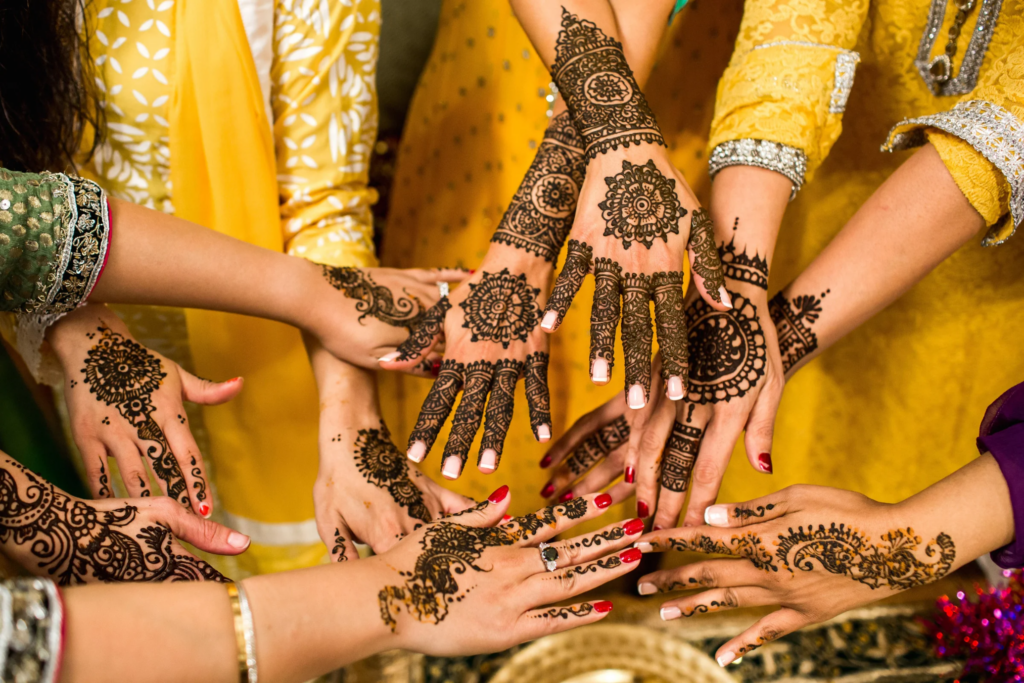
Express Your Individuality with Your Hands
When you want to show off your hands to your friends, you don’t just simply show off your fingers and nails. You need a canvas on your hands. Henna has been used for centuries as a form of body art by various cultures around the world. It’s prominent in India, Pakistan, and the Middle East as part of weddings and festivals. In this blog post, we’ll explain the various henna styles that are prevalent for henna designers.
- Indian or Arabic Henna
Indian or Arabic Henna is one of the most well-known styles of henna art. This style typically features intricate, ornate designs that cover the entire hand and often extend up the arm. The designs often incorporate intricate floral and paisley motifs, as well as delicate vine-like patterns. These designs can be very detailed and complex, with a high level of precision and symmetry.
Indian and Arabic henna designs are often used for special occasions, such as weddings or festivals. They can be applied to both the hands and feet, and are often paired with traditional attire such as sarees or abayas. In addition to their aesthetic appeal, Indian and Arabic henna designs are also believed to have cultural and religious significance and are often used as a symbol of good luck, fertility, or protection.
- Moroccan Henna
Moroccan Henna is a unique style of henna art that is characterized by its use of bold, graphic designs and patterns. Unlike Indian or Arabic henna, which often feature intricate floral and paisley motifs, Moroccan henna designs typically incorporate geometric shapes and patterns, such as squares, triangles, and diamonds. These shapes are often arranged in intricate, repeating patterns, creating a sense of symmetry and balance.
- African Henna
African Henna is another style of henna art that is characterized by its use of bold, graphic designs featuring large, blocky shapes and patterns. African henna designs typically incorporate large, abstract shapes, such as squares, rectangles, and triangles. These shapes are often arranged in symmetrical or asymmetrical patterns, creating a sense of balance and movement.
- Western Henna
Western Henna is a contemporary style of henna art that has gained popularity in recent years. This style of henna often incorporates modern designs and motifs, such as hearts, stars, butterflies, and other symbols that are popular in Western culture. Unlike traditional henna styles such as Indian, Arabic, Moroccan, or African, Western henna is not bound by cultural or religious traditions and allows for greater creative freedom and experimentation.
Western henna designs can be applied to various parts of the body, including the hands, feet, arms, and legs, and are often used for special occasions such as parties, concerts, or festivals. Unlike traditional henna styles, which are often associated with weddings or religious ceremonies, Western henna is often used purely for aesthetic purposes.
- Bridal Henna
Bridal Henna is a popular and intricate style of henna art that is often used for weddings and other special occasions. Bridal henna designs are characterized by their complexity, featuring intricate motifs and patterns that cover both the hands and feet. Unlike other henna styles, which may only cover a portion of the body, bridal henna is typically more elaborate and extensive, requiring several hours or even days to complete. Bridal henna designs often incorporate traditional symbols and motifs, such as flowers, paisleys, and geometric shapes, that are believed to bring good luck and prosperity to the bride.
- Tattoo-style Henna
Tattoo-style henna, also known as black henna or jagua henna, is a unique style of henna art that is becoming increasingly popular. Unlike traditional henna designs, which typically result in a reddish-brown color, tattoo-style henna uses a different type of dye that results in a dark, almost-black color that resembles a real tattoo.
What sets tattoo-style henna apart from traditional henna is the level of detail and shading used in the designs. Artists who specialize in this style of henna use techniques similar to those used in tattooing, such as layering and shading, to create a more permanent-looking effect. Designs may include intricate patterns, portraits, animals, or other detailed images that look like real tattoos.
- Minimalist Henna
Minimalist Henna is characterized by its simple and clean designs. This style is particularly popular among those who prefer a more subtle and understated look. Rather than using elaborate motifs and patterns, minimalist henna designs typically feature clean, geometric shapes and delicate lines.
What sets minimalist henna apart from other styles of henna is its emphasis on negative space. Rather than filling the entire hand or arm with intricate designs, minimalist henna designs often incorporate areas of bare skin, which allows the design to stand out more and creates a more modern and minimalist look.
- Fusion Henna
Fusion Henna combines traditional henna designs with elements of other art forms. This style of henna art is popular among artists who like to experiment with different design techniques and styles. By incorporating elements of other art forms, Fusion Henna offers a fresh take on traditional henna designs and allows artists to create truly one-of-a-kind pieces.
Conclusion
When it comes to using your hands as a canvas, having them filled with henna is the perfect way to show off your beauty. Choosing one of these 8 designs will make your decision easier if you ever want your hands designed with henna for either a wedding or a festival. That’s why you can get it done on Sirwiss as we can guarantee you henna designs from a beauty salon that can come into your home.